This will allow you to automatically reference a surface or plane as the supporting element whenever you need one, when creating lines for example. You will no longer have to explicitly select the support element.
It will also allow you to create reference points on the fly in the support, whenever you need a reference point to create other geometric elements.
Open the WorkOnSupport1.CATPart document.
Creating a support from a surface
-
Click Work on Support
 .
.The Work On Support dialog box appears. 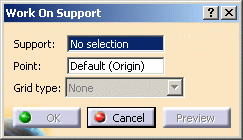
-
Select the surface to be used as support element.
If a plane is selected, a grid is displayed to facilitate visualization. -
Optionally, select a point.
By default the surface's midpoint is selected. 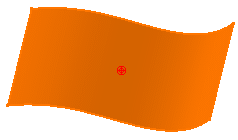
-
Click OK in the dialog box.
The element (identified as Working support.xxx) is added to the specification tree under the Working supports node. 
Creating a support from a plane
-
Click Work on Support
 .
. -
Select the plane to be used as support element.
The Work On Support dialog box is displayed, allowing you to define the plane: 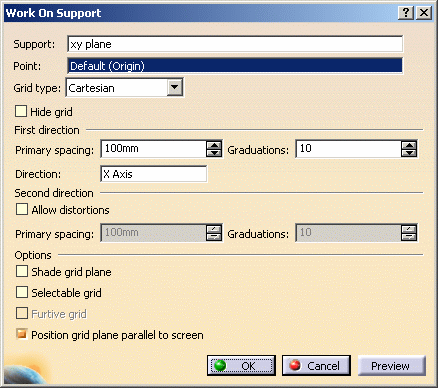
By default, the Grid type is set to Cartesian, to define a Cartesian plane. 
A grid is displayed to facilitate visualization. You can hide it by checking the Hide grid option. -
Select a point, as the support plane's origin.
By default the plane's origin is selected. Beware of the plane representation not being located at the plane's origin. In this case, the default point, really is displayed at the origin and therefore not necessarily onto the plane representation. -
Define the First direction scale (H for horizontal), by setting Primary spacing and Graduations values.
-
If needed, select a direction to specify the H direction.
You can right-click in the editable field to display the contextual menu and define the direction (by defining its vector, creating a line, and so forth). -
If you wish, you can define another scale for the Second direction (V for vertical), thus allowing distortions of the grid. Check Allow distortions to activate the Primary spacing and Graduations fields for the second direction.
-
You can check Shade grid plane to visualize the support plane as a solid geometric element.

This is possible only if the View mode is adequate. -
You can check Selectable grid to enable the selection of sub-elements of the grid (lines and points) as a support for a future selection.
Selected sub-elements are featurized. -
You can check Furtive grid to see the grid only when it is parallel to the screen.

This option is only active only if Selectable grid is checked. -
You can check Position grid plane parallel to screen to reset the grid visualization parallel to the screen.

Primary spacing and Graduations are defined in Tools > Options > Shape > Generative Shape Design.
Refer to the Customizing section for further information. -
Click OK in the dialog box.
The element (identified as Working support.xxx) is added to the specification tree. 
Creating an infinite plane from a limited planar surface
-
Click Work on Support
 .
. -
Select a face of Extrude.1.
A warning message is issued asking you whether you wish to create an infinite work on support from this face. 
-
If you click Yes, the plane is inserted in the current geometrical set or ordered geometrical set and is used as the Support. You will be able to create features on this support.
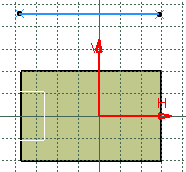
-
If you click No, only the face is used as the Support. You will only be able to create features on this limited face.
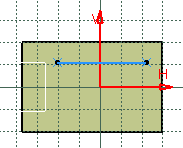
-
Creating an infinite axis from the active work on support
Let's take an example with the Rotate command.
-
Click Rotate
 .
.The Rotate Definition dialog box opens. -
Select the Spline as the element to be rotated.
-
Select the axis.
There are two ways to create an infinite axis on the fly: - Click anywhere on the Work on Support.
The point and the axis needed for the axis are created. 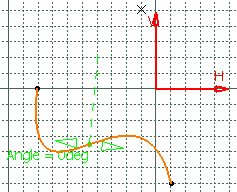
- Select a point in the 3D geometry.
The axis is created through this point and is normal to the active Work on Support. 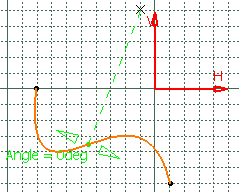
- Click anywhere on the Work on Support.
-
Click OK to create the rotated element.
The axis is an infinite line normal to the support and passing through the featurized point. This line is aggregated to the Rotate.x feature and put in no show. 
This capability is available with a Work on Support defined by a planar element (whether finite or not).
Setting a work on support as current
Select the Set As Current/Set As Not Current contextual item on the working support features or click Working Supports Activity
Snapping to a point
- Use the Get Features on Support contextual item on the working support features to retrieve the features created from a single or a multi-selection works on support. As a result, the retrieved features are selected in the current editor and highlighted in the specification tree, therefore allowing you to use them more easily.
- Points created while in the Work on Support command, regardless of the type of working support created (surface or plane), are aggregated under the Working support and put in no show.
- Regardless of the type of working support created (surface or plane), once you choose to work on the support, you can directly click onto the support to create points. This capability is available with commands such as point, line, spline, polyline, and most commands where you need to select points as inputs.
The created points using a support are aggregated under the parent command that created them and put in no show in the specification tree. - The children that appear under any feature may not follow the same order as their order of creation.
- Working supports can be edited, updated, or deleted just as any other feature.
![]()


